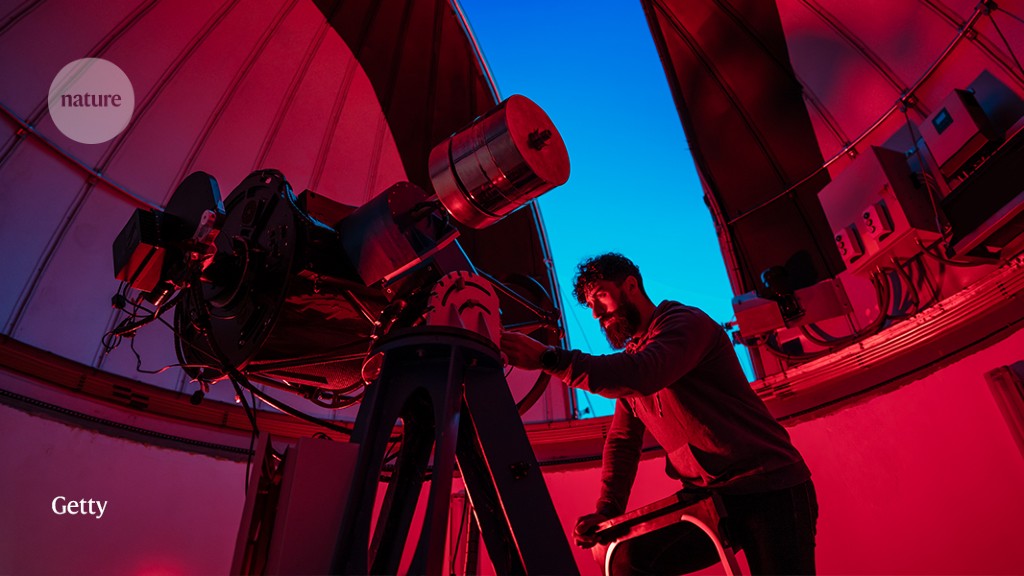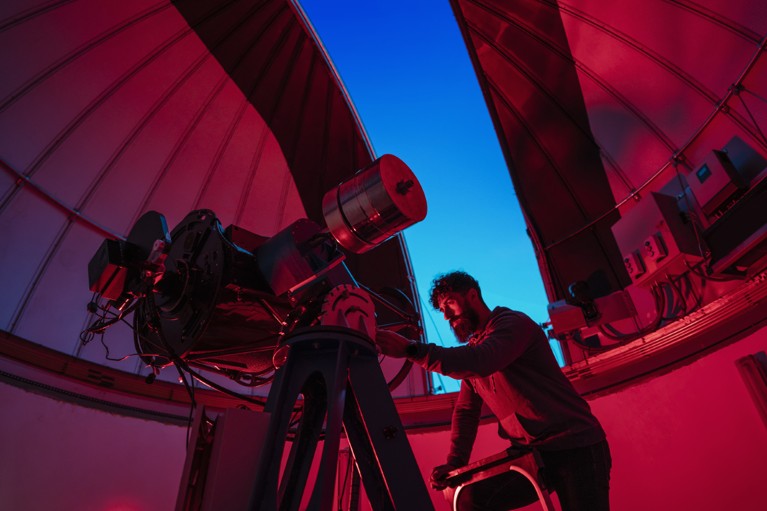Astronomical observatories require vast amounts of energy to run.Credit: Getty
Michael Inouye, a computational biologist at the Baker Heart and Diabetes Institute in Melbourne, Australia, has always worried about the carbon emissions that his research was generating. But it was the unprecedented wildfires in Australia in 2019 and 2020, which were made more likely by climate change and shut down his laboratory, that pushed him to take action. In 2020, he began collaborating with two PhD students to measure the carbon emissions of their computational research. The project created Green Algorithms, a free online calculator that allows users to estimate the carbon footprint of their research projects, in a bid to ultimately reduce emissions.
Inouye has been using the calculator since it launched, but last year he took things a step further. After calculating the emissions of one of his team’s projects1 on human genetics and diet, his group planted 30 trees to counter its emissions. Inouye knows that offsetting practices are controversial. Critics of the practice argue that if the trees are not properly monitored, there is no guarantee that they will still be alive the following year, for example. “But I think, it’s better to do something than nothing,” he says.
He is not alone. As the impacts of climate change grow, researchers from fields spanning astronomy to biology have been working to understand and address the sources of their emissions. But solutions don’t come without obstacles.
Archive data
In 2019, a group of scientists at the Institute for Research in Astrophysics and Planetology (IRAP) in Toulouse, France, measured their institution’s greenhouse-gas emissions. They included electricity, heating, water, air conditioning, professional travel and the energy required for computing. “The observatories were the biggest contributors to our carbon footprint,” says Jürgen Knödlseder, an astrophysicist at IRAP who co-authored a paper on the emissions study2, published in November 2022.
In 2019, the footprint attributed to the use of observatory data was 4,100 tonnes of carbon dioxide emissions, the equivalent of 2,050 petrol cars running all year in the United Kingdom. You need a lot of electricity to run the observatory, says Knödlseder.
The results spurred the scientists to think about how to decarbonize their work when their main source of emissions is the technology they rely on to make breakthroughs.
One option is to pause the collection of new information and do research on archived data instead, says Knödlseder, who has started such projects with his PhD students. “When you think about it, you prepare an observatory for a couple of years, then the thing is launched and you do two or three years of data analysis, and then you jump to the next project. But the orbiting satellite is still running, it is still getting good data,” he says.
Clinical-trial footprints
Biomedical researchers face similar issues. “Clinical trials, especially when designed in certain ways, can be very carbon intensive,” says Rustam Al-Shahi Salman, a neurologist at the University of Edinburgh. In 2021, he co-authored an article3 with the Sustainable Healthcare Coalition in London — an organization that promotes green practices in the sector — proposing a strategy for measuring the carbon footprint of clinical trials. The tool is being tested and the results should be available later this year, says Al-Shahi Salman.
Previous studies have focused on estimating emissions from buildings and from researchers, patients and staff travelling to the trial site, Al-Shahi Salman says. For example, a 2011 study found that the carbon emissions of two clinical trials that tested the effects of corticosteroids in people with brain injuries ranged from 181.3 to 108.2 tonnes of carbon emissions4. The transport of trial materials and the energy to power the trial-coordination building produced the largest footprints.
One way to reduce emissions would be to continue using telemedicine strategies implemented during the COVID-19 pandemic, such as holding meetings, gaining patient consent and doing follow-ups by video, or asking patients to wear health-monitoring devices.
But some parts of the clinical-trial process require institutional interventions to make them greener, such as the manufacturing and distribution of drugs and placebos, says Al-Shahi Salman.
Culture change
Reducing research emissions on a large scale requires institutional support, says Pierrick Martin, an astrophysicist at IRAP. “The situation is not that different from the one you can experience as a citizen. There are things you can do yourself, at your level, in your local environment, that are worth something. But this has limits, and you can’t escape from political decisions at some point.”
And the time to reach a consensus is running out. The Intergovernmental Panel on Climate Change set the net-zero emissions goal for 2050 — a demanding target, says Martin. The closest the world came to cutting emissions that drastically was during pandemic lockdowns, which cut global CO2 emissions by close to 10%. “This is what we are supposed to achieve every year,” says Martin.
Institutions should start studying how they can reduce their carbon footprint instead of just measuring it, Martin adds. “If everybody starts to count carbon-footprint assessments, this will take years,” he said. “As soon as you have a few carbon-footprint assessments here and there in different countries or different infrastructures, you start to have a pretty good idea of what you need to do.”
One way to push things forward would be for institutions to ask scientists for emissions-reduction strategies as a condition of grants or jobs. But this is challenging for research institutions who are not used to considering their emissions, says Knud Jahnke, a cosmologist at the Max Planck Institute for Astronomy in Heidelberg, Germany. “It’s fundamentally human and fundamentally challenging for big organizations because if they’re big, they’re well-oiled in the way they’re used to operate.”








More News
Full-colour 3D holographic augmented-reality displays with metasurface waveguides – Nature
Observation of Nagaoka polarons in a Fermi–Hubbard quantum simulator – Nature
Lithium tantalate photonic integrated circuits for volume manufacturing – Nature